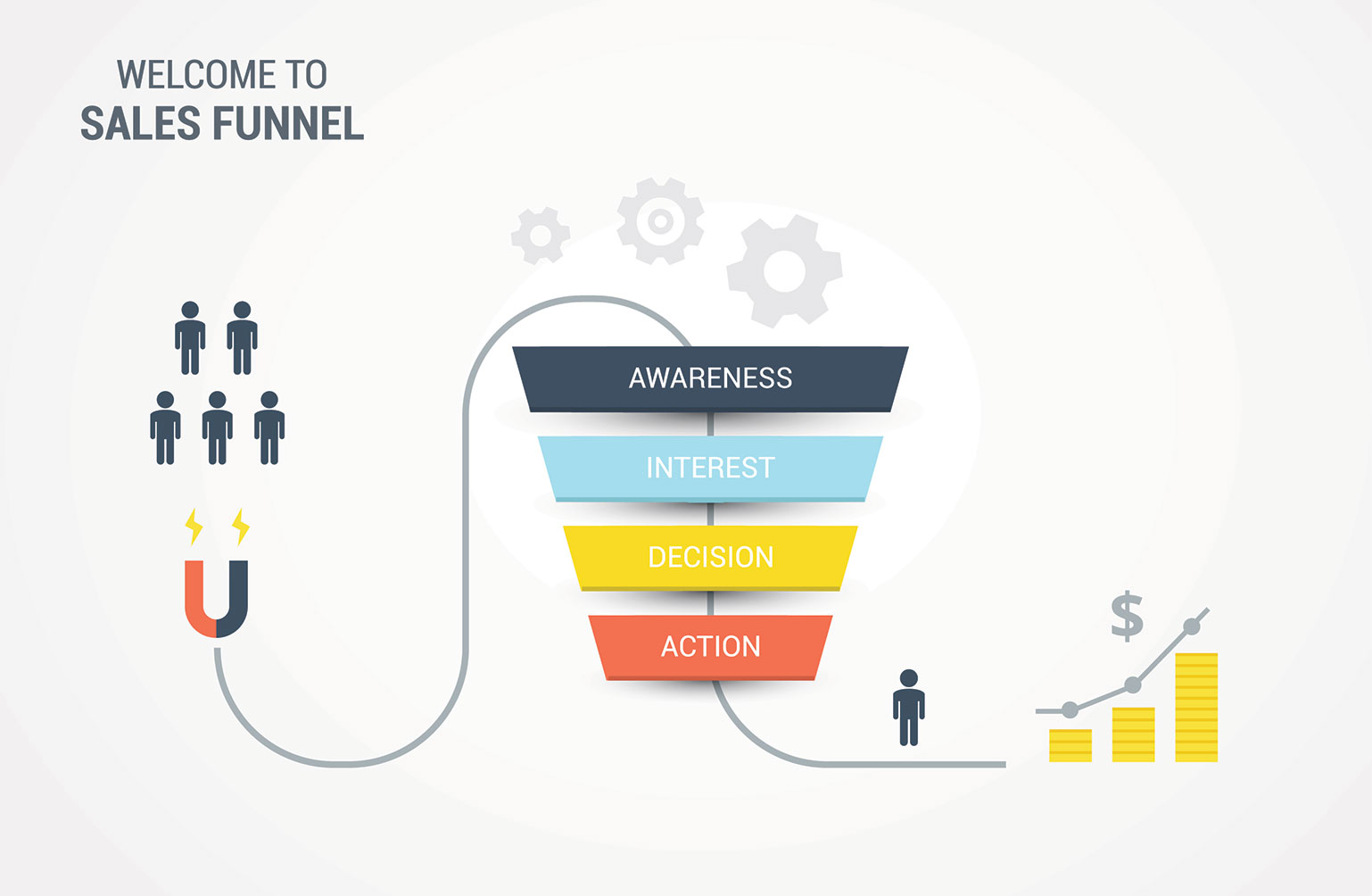When it comes to finding and building your consumer base, any method that doesn’t incorporate a sales funnel is sure to fail. Sales funnels are integral to growing your brand from a small startup to a multi-million dollar company. Without it, your marketing team will flounder and your sales numbers stay low. Read on for our guide to creating a sales funnel for your business.
What is a sales funnel?
A sales funnel is a marketing plan that outlines how to actively engage consumers throughout the buying process. It encourages them to move from being unaware of your brand entirely to making their first purchase and beyond. It’s important to state right off the bat that not everyone who enters the sales funnel will exit the sales funnel. If every potential lead became a buyer, we’d all be rolling in dough. Instead, this method helps filter different levels of consumer interest to pull in people who will actively make purchases.
The ultimate goal of the sales funnel is to solve your customer’s problem. How do you discover your consumer’s concerns? By establishing detailed buyer personas. Each persona will reveal to you what that niche of consumer needs to hear to pull the trigger and make a purchase. No one sales funnel will satisfy all your consumers, as each persona has varying concerns and problems that need to be addressed. Once you know your consumers’ problems, you can guide them through a psychological narrative that explains why your product is the best solution.
Content is king when it comes to creating a sales funnel that works. Every stage of the sales funnel revolves around content with a specific goal in mind. If you’re not willing to invest in your content, you’re already falling behind. Nothing else will matter if you don’t have the content strategy to back it up. No cutting corners here. Invest in your content creation properly, and your sales funnel will function much more efficiently.
The sales funnel is comprised of four stages: Awareness, Interest, Decision, and Action. Each stage has its own concerns to be addressed to move consumers through to the next stage. Focus on solving the problem at hand for each stage while continuing to look at the flow of the funnel as a whole.
Stage 1: Awareness
At this stage, consumers don’t know who you are. They’ve either never heard of you or only have the faintest idea of who you are. Now is the time to really examine who the core of your audience base is. Pull out those buyer personas and figure out what they really want.
Then, think about your personal brand. What do you have to offer as a potential solution to your consumers? Who would care about your brand and why? What story do you want to put out there?
Combine your personal brand with your consumers’ interests, and you’ll have an idea of how to approach them for the first time. Now you just need to get in front of them.
This is where the Internet becomes your best friend. Thanks to technology, you have no shortage of ways to place content in front of your audience. Social media, blogs, and paid advertisements are all great ways to garner initial awareness. Of course, you’ll need a beautifully designed site that has been optimized for SEO to direct them to. Optimizing also raises your rank in Google, making it easier for consumers to find you organically.
Your funnel plans will differ depending on the method people used to find your site. If they found you organically, you know that they have a specific problem in mind that you appeared as a solution for. Appearing organically also gives you some level of authority. People who found you via paid advertisement will need a little more convincing. Sure, they’ve shown mild interest in your content, but they weren’t actively seeking you out. Now it’s your job to convince them to stick around.
Once you’ve got some consumers in mind, you need to build interest with them. The best way to do this is by establishing a relationship with potential consumers to foster their curiosity.
 Stage 2: Interest
Stage 2: Interest
Now that you have some potential interest, it’s time to show them why they should stay interested. Ask yourself this question: Why should they invest in you? Seek to answer that question with the content you push to consumers.
You need to turn your consumers’ implicit needs into explicit needs. Tell them why the problem you’re addressing needs to be resolved immediately. Then provide them with a way to do just that. Provide incentives and a portal for them to keep receiving information.
A great way to do this is through content provided in a mailing list. Get them to sign up by providing a free incentive for getting involved. This could be a tutorial video or guide meant to address some of the questions they might have about their problems. Initially providing something of value for free primes them to be more willing to purchase something of value down the line.
Consistency is key at this stage. If you send out one e-mail update initially and then your consumers don’t hear from you for the next few months, they’re going to forget about you. Even worse, they might actively dislike a brand that is clearly not interested in engaging with them.
You need to have a solid content plan for your e-mail campaigns to keep things fresh and interesting without overloading or underwhelming consumers. Continue to be a source of exciting information that addresses consumer interests. Then, you can push them to choose your brand over the competition.
Stage 3: Decision
It’s crunch time. The Decision stage is the time to help consumers make up their mind about your brand. Will you be the brand they choose, or will they move on to the next thing?
Content is still the way to your consumers’ hearts, but now you can get a little sales-y. Offer them special discounts and exclusive incentives for making the move towards a purchase. Give them something special to help seal the deal.
This is where you want to address any and all objections your potential consumers might bring up. If there’s a problem you haven’t addressed thus far, this is your final chance to resolve it. You don’t want your customers to have hesitation as they hover over the purchase button.
Convince consumers by showing them how you’ve already helped others with this product. Testimonials and reviews create the credibility needed for your customers to fully trust you. This can be done through videos and cleverly designed e-mails, or you could promote this content as an ad towards people who have spent some time on your site already.
Only one step remains. You’ may not be pulling the numbers you were back at the awareness stage; that’s to be expected. But those who have made it this far are ready for the home stretch: the purchase.
Stage 4: Action
You’ve done it! Getting consumers to this stage means they’ve taken the action you’ve wanted since the awareness stage. For most brands, this will entail making a purchase of some kind.
Of course, your work isn’t finished just because your consumer made a purchase. This is just the beginning. You’ll need to keep that consumer coming back for more product (or different products if you have several lines!) This essentially means working them back through the funnel all over again. You’ll need to alter your content and approach to fit your new goals. It’s easier to retain one loyal customer then gain a new one, so don’t neglect those that have made it to the action stage!
Learning from the sales funnel
As you nudge consumers through the various stages of the funnel, you’ll begin to notice some kinks. Maybe it’s a certain stage where a large number drop off, or content you thought was golden that just isn’t doing anything for you. Your approach to your various funnels will need to constantly adapt and evolve with your consumers. Tracking what is and isn’t working can take months of data, so be patient if this is your first attempt at the sales funnel methodology.
If you want to create a truly successful sales funnel, timing is everything. You need to find the sweet spot for the amount of content your consumers want. Pay attention to every bit of feedback you get; it all reveals pieces to the bigger picture at hand. Put the pieces together, and you’ll have the perfect model to continuously find and create loyal consumers.
Would you like to learn more about creating a sales funnel, or about any other video marketing topic? Reach out to IDR for additional information and answers to all your questions. You’ll discover why we’re Orange County’s premier producer of TV commercials, infomercials, and online videos for a wide range of businesses, organizations, and brands.



